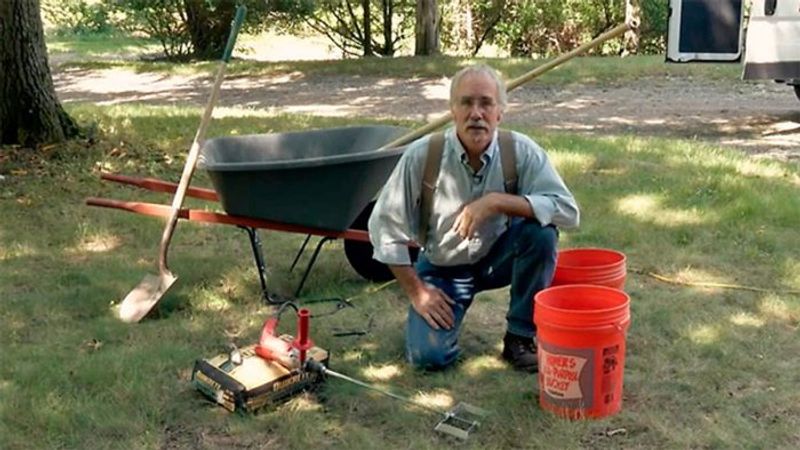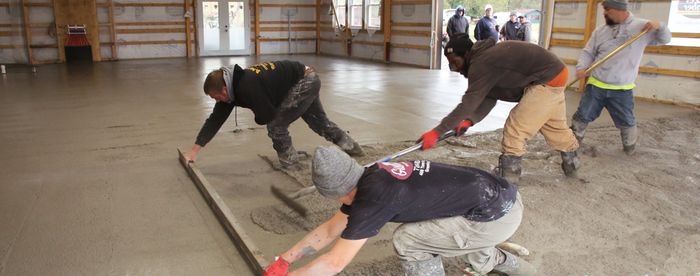Bucket-Mixed Concrete
A hoe and a wheelbarrow aren't the only common tools you can use to mix small batches of concrete.

If you have to mix concrete with a cement mixer you could get a wheelbarrow, a shovel, and a mixing hoe; dump the concrete in, add water, drag all that concrete to one side, and then drag it back to the other side … but there’s a better way. Here’s a tip that Mike Banke posted on our website. He had to mix a bunch of concrete by hand, and rather than use a wheelbarrow, he decided he could do it faster with a 5-gallon bucket, a 1/2-inch drill, and a paddle mixer. Step 1 is to pour some clean water into a bucket, add a 60-lb. bag of concrete to the water, and then mix with the drill, starting slowly and then speeding up.
More about mixing concrete:
Beach-Blanket Concrete Mixing — A sheet of plastic is the key to this trick for mixing a small batch of concrete for a spot the ready-mix truck couldn’t reach.
Hand Mixing Concrete — Adding the right amount of water is one key, but a thorough mix is just as important.
Mix Concrete by the Bag — A reliable and back-friendly approach to this common chore.





View Comments
Great tip,,,Timely for me too. Thanks
Don't burn up your drill motor by running it too slow for too long under high torque load. Consider adding the concrete in parts. The drill is air cooled, and if it is stalled the fan doesn't move any air and current is high. With gloves on you might not notice how hot it's getting until too late.
What are we building ? Quickrete sure beats the heck out overheating my electric drill if I was lucky enough to even find it ! Oh ! okay honey I heard you - we sold it at the last yard sale !!!!!
Well... tried this tip last weekend - and killed my 1/2" drill, concrete (mixed per instructions on the bag) was way too stiff to move under the power of a drill. Not sure I'd recommend this tip.
Where did you get this paddle mixer and how big was the drill?
Like ODM says, hard on drill motors- I had to put way more than the bag-recommended amount of water in the concrete for the drill to move it. I'd try an eggbeater paddle, ( http://www.qep.com/products/professional-mixing-paddle/ )rather than the one shown- it's smaller diameter, not as hard on the drill motor.
And, yeah, I bought a "Chicago Electric" drill motor- I don't think my wife sold my 45 year old B&D, but I can't find it in my garage...
There's one other hazard to keep in mind...
I was using my new 1/2" Chicago Electric drill motor to mix thinset in a 2 gallon bucket, holding the bucket by squeezing it with my feet, but apparently that isn't a good idea. The bucket started spinning, the thinset climbed out of the bucket and I ended up hosing down my shoes, my socks, the sidewalk, the side of the client's house and the fiver I was using for the dry thinset. Other than that, everything was great!
Since I'm the guy who submitted this technique, please let me elaborate: I use a Milwaukee HoleHawg drill motor on low-range. I leave the whip in the bucket, add 4 quarts and one pint of water, 60 pounds of concrete, blend, rinse and repeat. I always wear my rain pants and boots as it can sometimes slop over. Also, I always keep a 5 gallon bucket of water nearby to clean the whip. I can do 20 bags in one hour.
I used a smaller mixing whip with a Ryobi rechargeable drill when leveling and repairing my basement concrete floor. Not using concrete however, mostly mortar mix and a self-leveling blend for final pour before laying slate. Now I have bigger toys . . .
MikeJ,
Now you tell me about the boots and rain pants...
FWIW, my wife's "agricultural strength vinegar" (30% acetic acid) took the thinset out of my socks. Time will tell if it also took the sock out of my socks.
I never got up to 20 bags an hour, but I did do 5 bags of self-leveler in 20 minutes.
I have used this method for small batches for years, however I have found it best to first add water and then add just a little dry mix at time, mixing well, then adding more until I have the amount and consistency I want. This puts less stress on the drill...and your wrists..
Use this and it won't be hard on your drill.
http://www.mud-monster.com/store/c1/Featured_Products.html
One more addition to the thread- as noted below, one of the hazards is the bucket spinning and throwing cement or thinset or self-leveler all over. At JLC Live in Portland (Sorry FH...) I was talking to an old tilesetter and asked him how he kept the bucket from spinning. He looked at me like he was talking to a 4 year old and said, "You put one foot on the rim of the bucket..."
I definitely think the low range setting on the drill will help save the motor, Mike. I may try this next time I need concrete.
I already have the drill and paddle for grout, so I'll try it on a couple bags next time.
Since we're on the topic, I've gone to using a steel rake to mix 2 bags at a time in a wheelbarrow and it's a lot faster than a mixing hoe.
That's a REALLY good way to burn your drill out.
I would only try it with a heavy duty right angle drill!
The paddle mixers are designed for paint and joint compound. Significantly reducing the diameter of the paddle will reduce the amount of torque to a level the drill can handle. A 1/2" pipe will spin effortlessly but not mix the concrete. Somewhere around 1.5" to 2" diameter paddle might work w/o burning out a drill. It will kick up a fair amount of dust, so wear a mask and glasses.
Ok, I've mixed a LOT of morter and plaster, stucco with a paddle mixer. You really want to get the low speed kind. Look for one that goes 400-600 rpm. Not variable speed, but geared down. old Black and Decker, Milwaukee others made them. Big motors with a 3/4" pipe threaded handle on the body to deal with the torque.
I've used buckets and I've used metal trash cans up to 20 gallons. We'd tie them onto hand trucks and mix at the materials pile, then hand truck whole thing over to plasterers. No transfer from mixer to wheel barrow. Keep a couple going.
Most important thing is to add water first to make it easier to start. Don't add too much.
Concrete, even sakcrete premix is a tough proposition for drill/paddle mixing even with the big motors and water first. I would rather mix on the ground with shovels or even in a wheelbarrow (see FH method for wheelbarrow mixing) over bucket mixing. The weight and desired dryness of concrete compacts it into the bottom too much.
Morter, stucco, plaster, great technique.